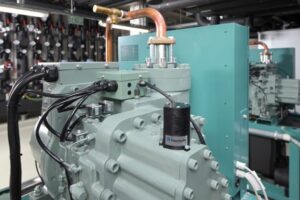Sensors are key elements of the Internet of Things (IoT). They collect information, for example, about the condition of a machine or an infrastructure, process it and pass it on. The numerous sensors can obtain the required energy from batteries or via a cable connection. Fraunhofer researchers have now found a way to harvest enough energy to operate these sensors using vibrations from machines, equipment or buildings, as well as from temperature differences between pipes, lines or valves, and the environment.
“Powering a sensor node through energy harvesting technology makes it independent from other energy supplies. This saves the cost arising from energy-storage devices, such as a batteries, and eliminates the maintenance effort required for battery replacement. It also makes cable installations redundant,” says Dr. Peter Spies from the Fraunhofer Institute for Integrated Circuits IIS in Nuremberg, explaining the advantages. The autonomous sensors are used for data collection and transmission, e.g., for the condition monitoring of machines, buildings or bridges, as well as for smart metering systems.

© Kurt Fuchs / Fraunhofer IIS
A piezoelectric vibration converter supplies energy to sensors used in a building condition monitoring system.
Spies and his team have been researching for some time how and where energy harvesting technologies can be optimized and deployed. Due to the rise in energy prices, their field of research is rapidly gaining relevance, and inquiries from industry are piling up. Their latest development is a so-called NarrowBand IoT module that collects and transmits utility data in a 5G network. To ensure that the modules and sensors can be operated energy independently, they were specially measured and optimized for energy consumption. This opens up new possibilities for autonomously powering not only LPWANs (low-power wide-area networks) but also other radio systems with higher energy consumption and more advanced functionalities, such as bidirectional communication. The systems could then also be operated in a public network.
At the electronica 2022 trade show, held from November 15-18 in Munich, Fraunhofer IIS will be using the NarrowBand IoT module and a mioty® radio sensor to show how these sensors can be operated entirely without cables or batteries using a thermo-electric generator or a vibration converter. Also on display will be a smart screw connection whose preload force can be monitored remotely thanks to energy-autonomous sensor technology. This means that loose screws should no longer pose a safety risk to bridges, machines or buildings in the future.
Source: Fraunhofer Institute for Integrated Circuits IIS in Nuremberg – electronica – World’s leading trade fair and conference for electronics